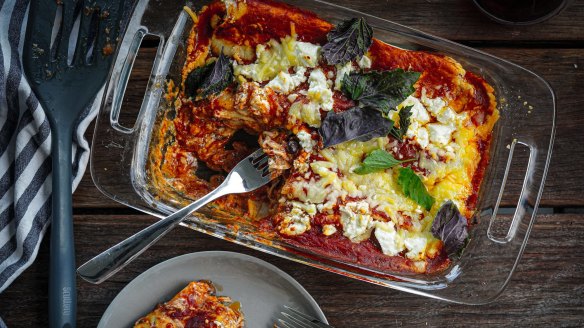Should you cool leftover food to room temperature before placing it in the fridge?

My partner and I have different views about safe storage of leftovers. Is it better to wait around and allow it to cool to room temperature before placing in the fridge or freezer, or put it in without delay? J. Larkins
From the way you framed this question it sounds like you're the get-it-into-the-fridge straight away kind of guy.
According to the Department of Health and Human Services Victoria, putting a large amount of very hot food into the fridge in one go could raise the temperature of all the contents of the fridge above 5C. The danger zone for food is between 5C and 60C over two hours. So, you want to reduce the temperature of the food to around 21C within two hours before you put it in the fridge.
To help cool the food down faster, you can increase the surface area by portioning it into smaller containers or spreading the food over a large tray to allow the heat to dissipate. Dishes such as rice can be forked through to bring more of the interior to the surface to exchange heat into the air. Seal containers and write the name of the contents plus the date on the lid.
Why is the Italian cheese called grana padano? K. Landsbury
Grana is Italian for "grain" and refers to the grainy texture of the cheese. It is made with partially skimmed milk, to which is added some of the previous day's whey, plus some rennet. The fine curds are hand cut and gently heated to release moisture, before being packed into hoops where the lactic acid fermentation takes over. The rinds are washed and the 24-40 kilogram wheels are matured for a minimum of nine months.
During that time, enzymes break down the protein from the milk into amino acids, and these form salts or "cheese crystals" that have a granular feeling on the tongue. These are more noticeable the longer the cheese is aged.
Padano comes from the Latin word for the Po River, Padus. According to European protection of origin laws, grano padano must be made in the Po Valley. Therefore, this grainy cheese made in the Po River Valley is called grana padano.
Compared to its older and more revered brother parmigiano-reggiano, grana padano is a softer, milder and less salty, milder tasting cheese that won't dominate a dish. It is therefore ideal for adding to dishes such as risotto. It is also cheaper than parmigiano so can be grated liberally into garlic bread or a cheese toastie, or over a soup, Roman-style abbacchio lamb or chicken parmigiana.
We harvested some chestnuts over Easter. How do we prepare them, and how long will they last? V. Gregory
Chestnuts are fresh food and will not last much longer than three weeks after harvest. Store them in an airtight container in the crisper in the fridge and preferably use them within 10 days.
To peel a chestnut, take a short sharp knife and make a nick or cross in the nut's flat base. Simmer in water for 15 minutes or roast at 180C for 15 minutes. Allow to cool enough to handle and peel, using the tip and blade of the knife. The skins are painful if they get under your fingernails. The brown inner skin should rub away with a clean dishcloth, but you may need to use the tip of the knife to work some of the skin out of deep crevices.
Send your vexing culinary conundrums to brainfood@richardcornish.com.au or tweet to @foodcornish
Appears in these collections
- More:
- Food
- Brain food
